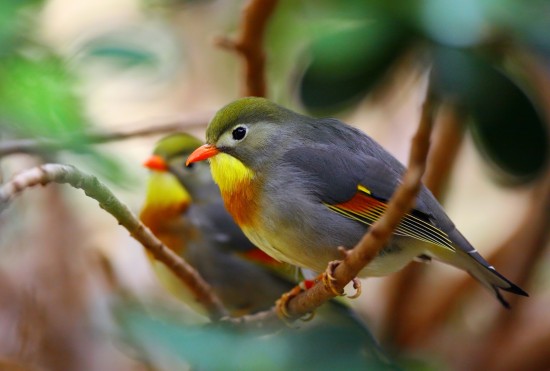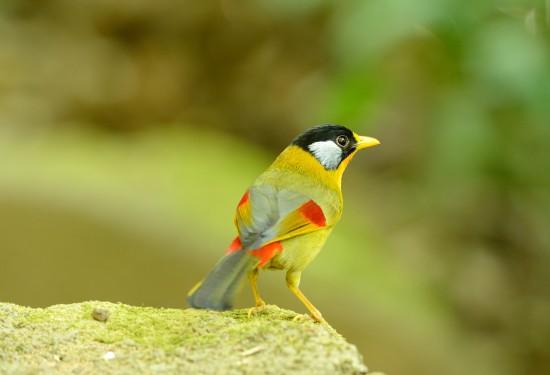


The Pekin Robin and the Silver-eared Mesia are part of the Laughingthrush family, a group of passerine birds mainly from the Old World that come in a range of sizes and colourations. They are mostly from the tropical areas of South-East Asia and the Indian subcontinent.
Of the birds in this family, the Pekin Robin (Leiothrix lutea) is probably the best known in aviculture in the UK. Its proper name is the Red-billed Leiothrix and it is also called the Pekin Nightingale. Their common name is a bit misleading as the bird is neither from China nor it is a robin. Typically, it is found in India, Bhutan, Nepal, Burma and in parts of Tibet where it lives in the hill forests as well as a range of types of forests, with pine forests being favourite. It can be found as high up as 7500 feet above sea level. It has also been successfully introduced to Hawaii and France but didn’t successfully transfer to Western Australia and in the UK.
These birds have a bright red beak, olive green backs and a yellow-orange throat area with a lighter yellow chin. They are generally around 6 inches in length and have brightly coloured wing feathers in yellow, orange, red and black along with a forked olive green tail. Females are generally dull than the males and juveniles have black bills. In the wild, they are very active and so are hard to see but known for their beautiful song.
In the wild, these birds feed on plants and live food such as insects. The main fruit it eats includes strawberries, ripened papaya and guavas as well as the fruits from other native trees. In captivity, this translates to a good universal food, insect paste and live food as well as fresh fruit and may eat vegetables such as leafy greens as well.
Keepers recommend keeping at least a pair of these birds as in time past, a single male was kept for his song. They can live in a cage but need to have it covered partially in greenery for them to settle or in a well-planted aviary. They are relatively hardy birds that don’t need full heat protection but will need a frost-free night house area in which to roost.
Pekin robins are very active birds that make use of their home and are most comfortable when in vegetation around the top of the aviary. However, this is not to say that they are particularly flighty and given time and patience, will learn to trust their keeper and may even come to the hand for food.
These birds make a nest from a range of fibres in a tree or may use a nesting box as a framework to build in. There are 3-4 eggs laid and incubated by the female and she also does most of the feeding when the chicks hatch 12 days or so later. The young are fed on live food such as mealworms, pinky maggots, buffalo worms and spiders and will not survive without access to this food. They fledge at around 14 days and are fed by the parents for around another three weeks after this. Their adult colouring comes at around three months old and as long as there is plenty of space, they can remain with their parents without fear of aggression.
The silver eared mesia (Leiothrix argentauris) is the only other bird in the family Leiothrix with the Pekin Robin. This bird comes from China, Malaysia, Thailand and Indonesia, particularly on Sumatra with various subspecies across its range. These are brightly coloured birds with silver face patches, yellow ochre throat and chest, olive green belly, grey upper wings with a red patch then the ochre yellow again on the ends of the wings and a black tail. The males have red-orange rumps while the females have yellow rumps and this is the main way to sex them. They are around 6 inches in length.
Mesias are best kept in pairs or small groups and live happily with other birds, even those that are smaller than they are. However, during breeding season they can need monitoring as there is a chance they may steal other birds’ eggs. They can live in a spacious cage but will need it to be planted or covered with greenery on some sides, as they will only settle when they have greenery. Similarly, in an aviary it needs to be well planted for them to be happy and feel safe. Favourite plants for this purpose are conifers, spruce and ivy. They are relatively hardy and don’t have special heat needs but do need to have a frost-free night house where they can roost. Mesias are very active birds that make use of the whole of their aviary though tend to use the lower parts of the aviary.
In the wild, these birds eat insects and their larvae with fruit and seeds to a lesser extent. They often forage in groups up to thirty birds and can join up with other species in the area including species of babblers. In captivity, a good universal food will form a basis of their diet with live food such as mealworms, pinky maggots, spiders, crickets and buffalo worms. Berries, raisins, bananas and pear are among their favourite fruits.
To breed these birds, put a nesting basket among ivy or other plants or they may construct their own nest from grasses and other materials. There are on average three eggs laid per clutch with both parents incubating them for around 12 days. The young are fed exclusively on live food for fledge at around 14 days old. For around two to three weeks after this, the parents feed the young and when they are independent, it is best to remove them from the enclosure to avoid aggression from the parents. However, if the aviary is large enough it is possible that the offspring can stay with their parents without problems.
Copyright © 2005-2016 Pet Information All Rights Reserved
Contact us: www162date@outlook.com